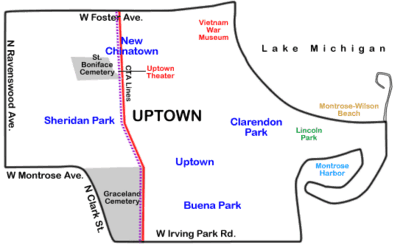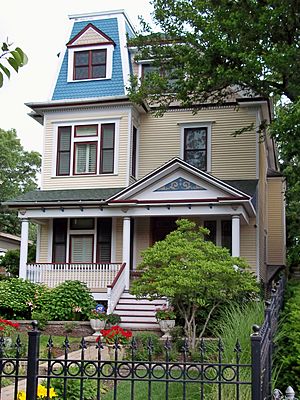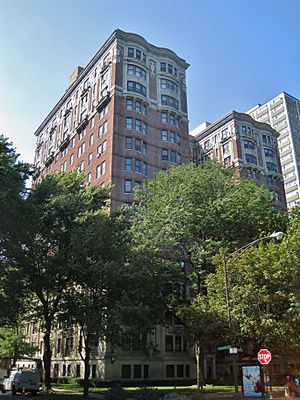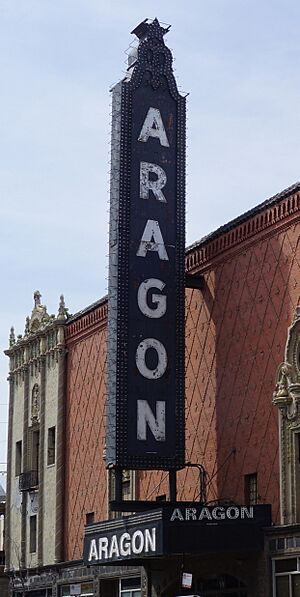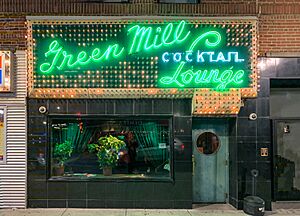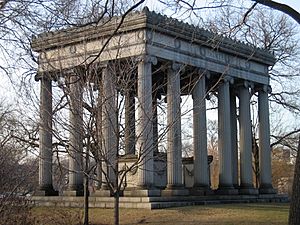Uptown, Chicago facts for kids
Quick facts for kids
Uptown
|
|
|---|---|
| Community Area 03 - Uptown | |
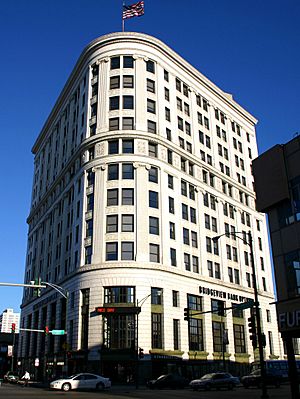
The Sheridan Trust and Savings Bank Building, on the corner of Broadway and Lawrence since 1924, has Chicago Landmark status.
|
|
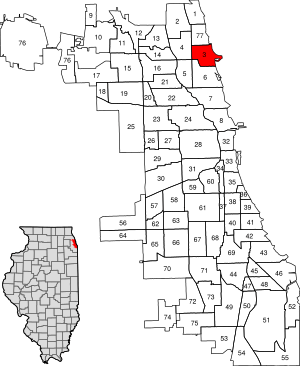
Location within the city of Chicago
|
|
| Country | United States |
| State | Illinois |
| County | Cook |
| City | Chicago |
| Area | |
| • Total | 2.33 sq mi (6.03 km2) |
| Population
(2020)
|
|
| • Total | 57,182 |
| • Density | 24,561/sq mi (9,483/km2) |
| Demographics 2019 | |
| • White | 54.2% |
| • Black | 17.8% |
| • Hispanic | 14.6% |
| • Asian | 10.5% |
| • Other | 2.9% |
| Educational Attainment 2019 | |
| • High School Diploma or Higher | 89.7% |
| • Bachelor's Degree or Higher | 56.4% |
| Time zone | UTC-6 (CST) |
| • Summer (DST) | UTC-5 (CDT) |
| ZIP Codes |
parts of 60613, 60640
|
| Median household income 2019 | $55,109 |
| Source: U.S. Census, Record Information Services | |
Uptown is one of Chicago's 77 community areas. It's located on the north side of the city, right next to Lake Michigan. Uptown is known for its mix of homes and businesses. It also has a lively entertainment area with many clubs and concert halls. In the past, it was a hub for early filmmaking.
You can find Truman College, a two-year city college, here. The famous 19th-century Graceland Cemetery is also in Uptown. Near the lake, you'll find parts of Lincoln Park, including Montrose Beach and several nature areas.
Exploring Uptown's Past
How Uptown Began
The heart of Uptown is Broadway, especially the area called Uptown Square. Around 1900, the Northwestern Elevated Railroad built its train station here. This station is now part of the CTA Red Line.
Uptown became a popular summer getaway for people living downtown. It got its name from the "Uptown Store," which was a main shopping spot. For a while, all northbound elevated trains from downtown ended in Uptown.
A Center for Entertainment
Uptown quickly became famous for entertainment. Stars like Charlie Chaplin and Gloria Swanson made movies at Essanay Studios on Argyle Street. Many famous venues are close to Lawrence and Broadway, including the Aragon Ballroom, Riviera Theater, Uptown Theatre, and Green Mill Jazz Club.
In the 1920s, many grand entertainment buildings were constructed in Uptown Square. Their beautiful designs were inspired by the World's Columbian Exposition. For over 100 years, Uptown has been a key entertainment district in Chicago. It played a big role in the jazz age, silent film era, and rock and roll era.
Changes Over Time
By the 1950s, many middle-class families moved to the suburbs. Uptown's older homes were divided into smaller apartments. People from the South and Appalachia moved into these affordable homes.
Later, new groups of Asian, Hispanic, and African-American people moved into the area. Large city projects, like Harry S. Truman College, changed the neighborhood. In the 2000s, Uptown started to see new development and rising property values.
Uptown's Unique Neighborhoods
| Historical population | |||
|---|---|---|---|
| Census | Pop. | %± | |
| 1930 | 67,699 | — | |
| 1940 | 77,677 | 14.7% | |
| 1950 | 84,462 | 8.7% | |
| 1960 | 76,103 | −9.9% | |
| 1970 | 74,838 | −1.7% | |
| 1980 | 64,414 | −13.9% | |
| 1990 | 63,839 | −0.9% | |
| 2000 | 63,568 | −0.4% | |
| 2010 | 56,362 | −11.3% | |
| 2020 | 57,182 | 1.5% | |
Buena Park
Buena Park is a neighborhood known for its beautiful homes. It's bordered by Montrose Avenue, Irving Park Road, Graceland Cemetery, and Lake Shore Drive. The Hutchinson Street Historic District within Buena Park has many Prairie-style mansions. These homes are very different from the tall buildings nearby.
This neighborhood was developed starting in 1887. You can reach Buena Park from the Sheridan stop on the CTA's Red Line.
Sheridan Park
Sheridan Park is mostly a residential area. It has many six-flat buildings, single-family homes, and courtyard apartments. A growing business area is found along Wilson Avenue. Truman College is also located here.
In 1985, the Sheridan Park Historic District was created. This helps protect the unique architecture of the homes. You can get to Sheridan Park from the Wilson or Lawrence stops on the CTA's Red Line.
Argyle Street: Asia on Argyle
This area is often called "Asia on Argyle," "Little Saigon," or "Little Vietnam." In the 1970s, many immigrants and refugees from China, Vietnam, and Cambodia made this neighborhood their home.
Asia on Argyle is famous for its Asian restaurants, cafes, and grocery stores. You can find Vietnamese, Thai, Laotian, and Chinese food here. In the summer, the Argyle Night Market is a popular street festival. The neighborhood is served by the Argyle stop on the CTA's Red Line.
Margate Park
Margate Park is in the northeast part of Uptown. It's located between Sheridan Road and Lincoln Park. The streets are lined with trees, historic mansions, and mid-rise buildings. These reflect the area's past as a busy entertainment hub.
The community is diverse. Many of the homes were built between the 1890s and 1920s. The Aquitania, a co-op building from 1923, is listed on the National Register of Historic Places. It was built by George K. Spoor, who co-founded Essanay Studios, a silent movie producer.
Famous Uptown Landmarks
Uptown Entertainment District
The Uptown Entertainment District was once a very popular place for tourists. It has many music venues, nightclubs, restaurants, and shops. This area is now seeing a comeback with new businesses opening.
Uptown Square, at the center of the district, became a National Historic District in 2000. Uptown is also a stop for Chicago Gangster tours, with places linked to famous figures like Al Capone.
Aragon Ballroom
The Aragon Ballroom is a very popular music venue. In the 1920s and 1930s, many famous jazz groups played here. Live radio broadcasts from the Aragon helped make its performers well-known.
Hotels grew up around Uptown, and it became a popular spot for young people to dance to Big Bands in the 1940s and 1950s. Many famous artists have performed here, including Frank Sinatra, Glenn Miller, The Rolling Stones, U2, and Nirvana. The Aragon Ballroom is near the Lawrence Red Line 'L' stop.
Riviera Theater
The Riviera Theater is another popular music venue. It used to be a grand Jazz Age movie palace that also featured live jazz performances. In the 1980s, its main floor seats were removed, and it became a concert hall.
Uptown Theatre

The Uptown Theatre is a huge, beautiful movie palace with almost 4,500 seats. It's the largest in Chicago and is listed on several Landmark Registers. The theater was designed by famous architects Rapp and Rapp, who also designed the Chicago Theatre.
There are plans to renovate and reopen the Uptown Theatre. This project aims to make it a spectacular entertainment venue again.
Green Mill Cocktail Lounge
The Green Mill Cocktail Lounge is located at 4802 N. Broadway. It was once part of a much larger outdoor music garden. The club was even owned by "Machine Gun" Jack McGurn, a close associate of Al Capone.
The Green Mill still hosts top jazz performers today. It also has a weekly Poetry Slam, which was started by poet Marc Smith.
Baton Show Lounge and Double Door
In late 2018, two well-known Chicago entertainment spots moved to Uptown. The Baton Show Lounge, which opened in 1969, features performance art. The popular indie music venue Double Door (established 1994) plans to reopen the historic Wilson Avenue Theater.
Former Entertainment Spots
The Rainbo
The Rainbo, at 4812 N. Clark Street, was once a very popular outdoor music garden. It was known as Mann's Million Dollar Rainbo Room and was said to be the largest nightclub in America. It featured big names in Vaudeville and music.
Later, it became a casino and sports venue. In 1934, during the Chicago World's Fair, it was called the French Casino. It then became Mike Todd's Theater Cafe, a popular dinner theater. In 1957, it was turned into an ice skating rink, the Rainbo Arena, used by the Chicago Blackhawks and Olympic figure skaters. The building was torn down in 2002 for new housing.
Arcadia Ballroom
The Arcadia Ballroom, at 4444 N. Broadway, was one of Chicago's first dance halls. It was one of the few places on the north side that would book black jazz bands in the 1920s and 1930s. The building was destroyed in a fire in the 1950s.
5100 Club
The 5100 Club, at 5100 N. Broadway, was a nightclub that hosted comedy shows before TV became popular. Comedian Danny Thomas was discovered here. He later became a big star in movies and on TV.
Argyle Street Restaurants and Shops
Argyle Street, especially from Sheridan to Broadway, is famous for its Chinese, Vietnamese, Thai, Laotian, and Cambodian restaurants and bakeries. You can also find many Asian grocery stores and shops selling unique goods. This area is often called "New Chinatown" or "Little Vietnam."
The surrounding neighborhood is listed on the National Register of Historic Places as the West Argyle Street Historic District. You can easily get there by the Argyle stop on the Red Line 'L.'
Graceland Cemetery
In southwestern Uptown, you'll find the historic Graceland Cemetery. Here, visitors can see the elaborate tombs of many famous Chicagoans. Since some of Chicago's well-known architects designed memorials and are buried here, the Chicago Architecture Foundation offers walking tours of the cemetery.
Winthrop Family Historical Garden
The Winthrop Family Historical Garden was created in 2009. It's a community green space on the 4600 block of Winthrop. It remembers the history of this block, which was a close-knit community for African Americans in 1931.
Uptown's Amenities
Parks and Fun Spots
Uptown has lots of parkland, especially Lincoln Park. This offers many chances for sports, relaxation, and exploring nature.
For sports, Lincoln Park has soccer fields, athletic fields, a golf course, and a sledding hill. The Chicago lakefront path is great for biking and running. Chase Park has indoor and outdoor sports facilities, a pool, and tennis courts. Clarendon Park and Margate Park also have athletic fields and playgrounds.
Dog owners can visit Montrose Dog Beach or Puptown Dog Park. Other fun spots include Montrose Beach and Montrose Harbor, a marina for boats.
The Montrose Beach Dunes Natural Area has dunes and wetlands. The Montrose Point Bird Sanctuary provides a safe place for plants and animals. The Uptown Natural Area offers nature trails through prairie and savanna.
Hospitals in Uptown
- Chicago Lakeshore Hospital
- Methodist Hospital of Chicago
- Thorek Memorial Hospital
- Louis A. Weiss Memorial Hospital
Schools and Learning
Chicago Public Schools operates public schools in Uptown:
- Elementary Schools: Brennemann, William C. Goudy, McCutcheon, McPherson, Ravenswood, Stockton, and Courtenay Language Arts Center.
- High Schools: Most students attend Senn High School, while some go to Amundsen High School.
- Magnet School: Walt Disney Magnet School is a CPS magnet school here.
- Other High School: Uplift Community High School is also in Uptown.
Private schools include St. Mary of the Lake Elementary School and St. Thomas of Canterbury Elementary School.
Colleges and universities in Uptown are:
- Harry S Truman College
- St. Augustine College
- American Islamic College
Libraries
The Chicago Public Library has two branches in Uptown:
- Bezazian Branch (opened 1957)
- Uptown Branch (opened 1993)
Cultural Spots
- The Haitian American Museum of Chicago
- The American Indian Center was in Uptown for many years before moving in 2017.
Getting Around Uptown
Uptown is well-connected by public transportation. The Chicago Transit Authority's Red Line serves the neighborhood with the Argyle, Lawrence, and Wilson stops. This train runs 24 hours a day.
To the west, the Ravenswood station on Metra's Union Pacific / North Line offers commuter train service. Many CTA bus lines also serve Uptown, including the #92 Foster, #81 Lawrence, #22 Clark, and #36 Broadway. For bikers, Broadway and Lawrence Avenue have bicycle lanes. Drivers can use Lake Shore Drive with several exit ramps in Uptown.
Famous People from Uptown
- Eric Gunnar Gibson (1919–1944): A soldier who received the Medal of Honor for his bravery in World War II. He grew up in Uptown.
- Harold Ernest Goettler (1890–1918): An aviator awarded the Medal of Honor for his courage in World War I. He was raised in Uptown.
- Talen Horton-Tucker (born 2000): An NBA basketball player.
- George R. R. Martin (born 1948): A novelist best known for A Song of Ice and Fire (which inspired Game of Thrones). He lived in Uptown while volunteering.
- Ayanna Pressley (born 1974): A member of the United States House of Representatives. She lived in Uptown as a child.
- Iva Toguri D'Aquino (1916–2006): An English-language radio broadcaster during World War II. She lived in Uptown after the war.


